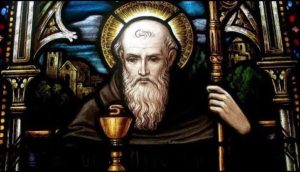 We may be surprised to learn that our earthly worship is an anticipation of, and a participation in, the heavenly worship. In heaven, the angels and saints perpetually proclaim the glory of God. They proclaim His glory, His honor, His beneficence, His virtues, His mercy, His Justice, etc., etc.
We may be surprised to learn that our earthly worship is an anticipation of, and a participation in, the heavenly worship. In heaven, the angels and saints perpetually proclaim the glory of God. They proclaim His glory, His honor, His beneficence, His virtues, His mercy, His Justice, etc., etc.
The “Opus Dei” (Divine Liturgy) refers to “the work of and for God” because He is working within us in order to make us more worthy of being in His presence. “Holy, Holy, Holy Lord God of hosts. Heaven and earth are full of Your glory.”
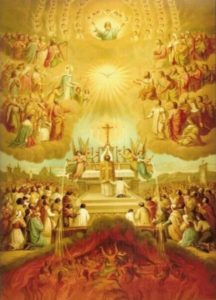 Christ serves forever as the Mediator, the Great High Priest in the heavenly tabernacle of God. The more worthy we participate in the divine liturgy, the closer we become to Christ. We are blessed to have a beautiful Church which helps us to have a more worthy focus as we sing and pray the Divine Liturgy.
Christ serves forever as the Mediator, the Great High Priest in the heavenly tabernacle of God. The more worthy we participate in the divine liturgy, the closer we become to Christ. We are blessed to have a beautiful Church which helps us to have a more worthy focus as we sing and pray the Divine Liturgy.
Even the liturgical furnishings of the Church provide their own significance for the overall worthiness of a proper liturgy. The ambo is the place where the scriptures and their commentaries are pronounced with great reverence. The candles are a reflection of Christ who is “the light of the world.” The silver and gold chalice(s) are made of the finest materials. The presider’s chair is a carryover from the Jewish people as the rabbi usually sat while giving instructions. Holy water and incense have particular rites for blessings and reverencing persons, altars, houses vessels, medals, bibles, cars, etc.
In order to proclaim a worthy liturgy, it is necessary that a lot of preparation goes on beforehand. The main celebrant, the readers, acolytes, musicians and singers, etc. all have their sacred part in the most sacred of sacrifices. Even the congregation, according to Vatican Council II, are urged to take an active part in the divine worship, singing and praying their parts. St. Augustine writes, “Whoever sings, prays twice.” The priest needs to deliver a well-prepared homily that edifies and helps to explain the readings and often can be applied to the current state of world and Church affairs.
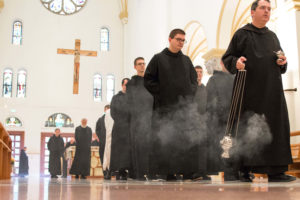 Even processions are important. The entrance procession with incense (which represents the prayers of the faithful) is reminiscent of Christ’s triumphal entry into Jerusalem on Palm Sunday. The altar of sacrifice is reverenced and incensed because it refers to Christ and His sacrifice. The procession of bringing gifts represents ourselves, our gifts, our family, our offerings, our life, etc. At the end of Mass, the recession out of Church challenges us with great conviction to “Go out to all the world and share the good news!”
Even processions are important. The entrance procession with incense (which represents the prayers of the faithful) is reminiscent of Christ’s triumphal entry into Jerusalem on Palm Sunday. The altar of sacrifice is reverenced and incensed because it refers to Christ and His sacrifice. The procession of bringing gifts represents ourselves, our gifts, our family, our offerings, our life, etc. At the end of Mass, the recession out of Church challenges us with great conviction to “Go out to all the world and share the good news!”
We are not to sit by and merely watch the whole ceremony of any given liturgy; we need to participate with enthusiasm for our salvation through the God-given gift of faith.
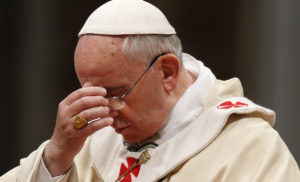
Gestures are to be done with great respect. Entering into the Lord’s Earthly Temple, we sign ourselves with the sign of the cross using holy water, then bow to the altar and genuflect to the tabernacle. When the gospel is announced we mark our forehead, lips and heart saying “May the Lord be in our mind, on our lips and in our heart.” We make a profound bow of the head on the feasts of Our Lord and the Blessed Virgin at the mention of their names, which represent their persons. There is a myriad of preparations, carefully learned and practiced that go into the overall presentation of a very fine liturgy, especially in a church that radiates dignity and holiness.
Let us revise some of these faith enhancing practices so that our whole life can become a worthy gift to God for all that He has done for us. Let us listen attentively to the prayers we pray and foster an awareness of God’s manifold gifts given in our lives through the sacraments, through each other.
Let us remember to be thankful to God for every grace or favor we receive, even the unfavorable ones. That way we can be sure we are still advancing on the road to holiness!
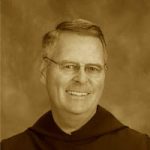 Br. Daniel Sokol is a Benedictine monk at Prince of Peace Abbey in Oceanside, California.
Br. Daniel Sokol is a Benedictine monk at Prince of Peace Abbey in Oceanside, California.